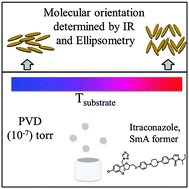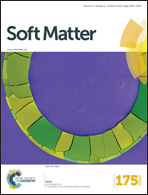Vapor deposition of a smectic liquid crystal: highly anisotropic, homogeneous glasses with tunable molecular orientation†
Abstract
Physical vapor deposition (PVD) has been used to prepare glasses of itraconazole, a smectic A liquid crystal. Glasses were deposited onto subtrates at a range of temperatures (Tsubstrate) near the glass transition temperature (Tg), with Tsubstrate/Tg ranging from 0.70 to 1.02. Infrared spectroscopy and spectroscopic ellipsometry were used to characterize the molecular orientation using the orientational order parameter, Sz, and the birefringence. We find that the molecules in glasses deposited at Tsubstrate = Tg are nearly perpendicular to the substrate (Sz = +0.66) while at lower Tsubstrate molecules are nearly parallel to the substrate (Sz = −0.45). The molecular orientation depends on the temperature of the substrate during preparation, allowing layered samples with differing orientations to be readily prepared. In addition, these vapor-deposited glasses are macroscopically homogeneous and molecularly flat. We interpret the combination of properties obtained for vapor-deposited glasses of itraconazole to result from a process where molecular orientation is determined by the structure and dynamics at the free surface of the glass during deposition. Vapor deposition of liquid crystals is likely a general approach for the preparation of highly anisotropic glasses with tunable molecular orientation for use in organic electronics and optoelectronics.


 Please wait while we load your content...
Please wait while we load your content...